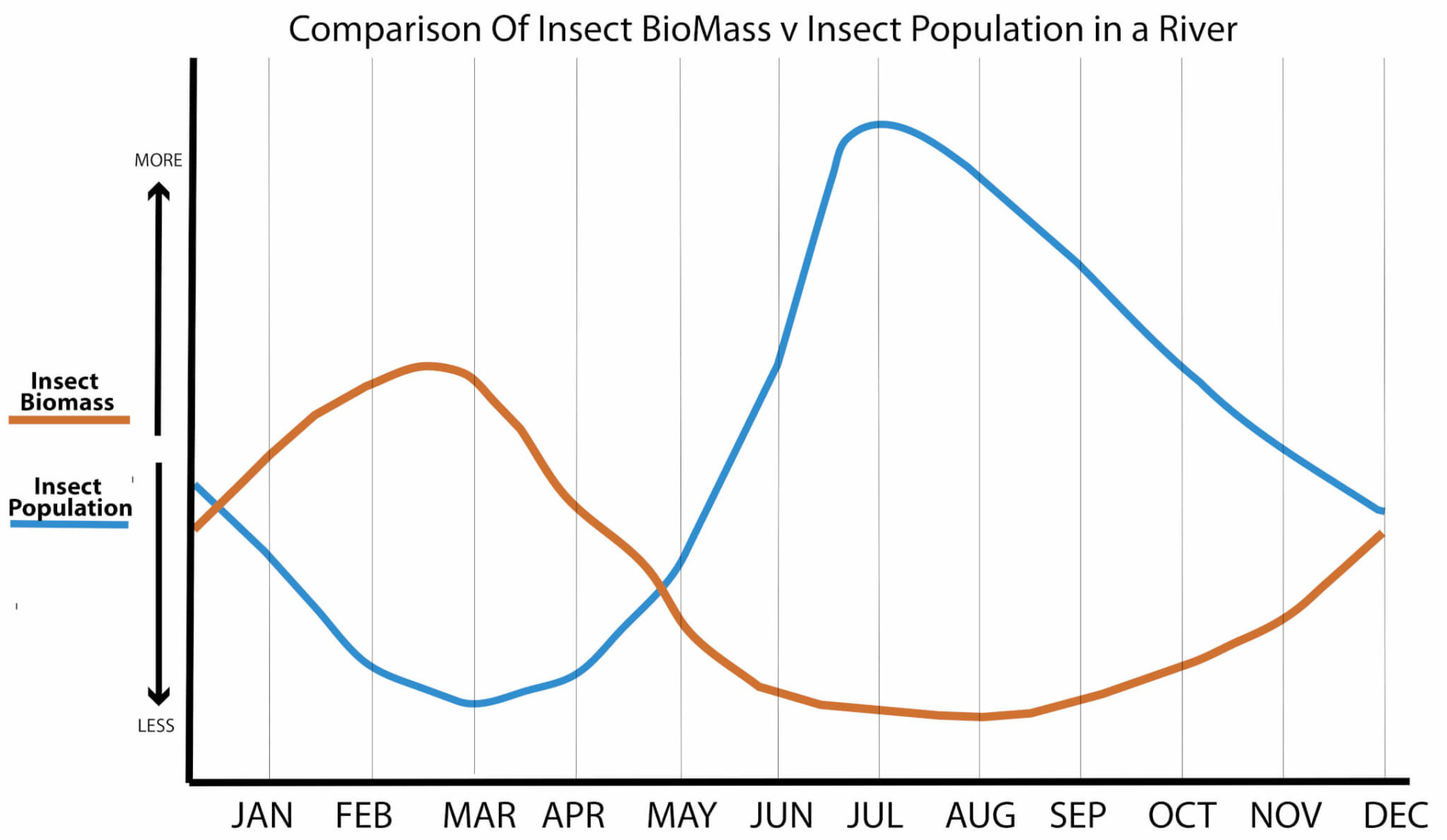Let’s start out with a few definitions. Insect biomass, for our purposes, is defined as the weight of all insects in a river at any specific time. Carrying capacity is defined as the maximum amount of life that can be sustained in a river system during the harshest conditions. Carrying capacity is always the nadir of population, as the harsh environment removes those less able to adapt to the conditions. That’s enough to be getting on with- more will be forthcoming.
If you look at the graph, there are two pieces of information being tracked. One is the fluctuating aquatic insect population over the course of a year in a river. Overlaid on that is a record of the fluctuating insect biomass over the course of a year in a river. These two pieces of information are critical to understanding the feeding habits of trout in a river.
Let’s follow the line created by the insect biomass in a river. You’ll notice it’s rising in January, and continuing through mid-March, when the insect biomass in the river is at it’s highest. Following the insect population line, you’ll see the insect population in the river is at it’s lowest. Reasoned out, the biomass has peaked because insects have been growing since they hatched, providing more biomass to the river. The insect population is correspondingly low. Few insects are added to the population over the winter, and natural selection and predation has brought the insect population to its lowest point.
And then the first hatches of spring occur. BWO’s, March Browns and Skwalas. As the insects leave the water to reproduce, biomass is depleted. Correspondingly, as the eggs from the spring insects hatch, the insect population begins to rise. However, these new insects are so small, they add little to the biomass of the river, only the population.
As you follow the two informational lines, they diverge until insect populations are at their highest in mid July. Which makes sense, as the bulk of the insects have emerged, and the corresponding eggs have hatched, pushing the population to its zenith. But these newly hatched insects are microscopic, with minimal biomass. By the end of July, the insect biomass in a river is at its lowest point.
These are some of the ramifications of this information. Ever wonder why winter nymphing is so good? With maximum biomass, the trout have access to the most food they will see all year. Jump to July, and the low biomass means food is at its minimum. Combine minimum biomass with the warmer water temps, and you’ve now established the carrying capacity for a river. These are the harshest conditions a river fish faces, and not all fish will survive these critical conditions.
The slash of a fish to a hopper, big fish rising to tiny tricos, the effectiveness of ants and beetles. Behaviors explained by this graph. With such a paucity of food in the river in July and August, fish are willing to be a bit less selective in their eating habits, and range a little farther from feeding lanes to take available food. When a sparkly purple and black thing floats over their heads, there’s a better chance the trout will eat it, because they’re hungrier now than they were in June.
As the natural cycle of insect growth moves on, the biomass of the river begins to recover in late August. Water temperatures drop in September, and the harshest period of the year has passed. The carrying capacity has been established for another year. The insect population will continue to fall, while the biomass rises until we hit March again, and the cycle starts again.
Few anglers use a nymph in a size 18 or 20. Yet this graph clearly shows there are smaller nymphs available throughout the year. As anglers, we get so focused on hatches that we sometimes forget to mimic the most abundant food form, which is small nymphs. The larger trout may not be exactly where you think they should be to take the “prevalent” insect. They may be in a prime location for size 20 nymphs, hoovering up the most abundant food source in the river. Another thought- because many stoneflies are on a two or three year life cycle, stonefly nymphs are always available to the trout. The rubberlegs we all fish so heavily in late spring is still just as effective in the summer and fall, because of the 365 presence of stonefly nymphs.
An understanding of the cycles of food sources in a river can help us understand some fish feeding behavior, and help explain why you can catch huge trout on tiny nymphs. It also may explain the Royal Wulff and Hippie Stomper’s success. Not a truly natural color or shape, but when the fish are hungry, those flies look enough like food to get eaten. Armed with a little knowledge, you may find your catch rate going up in all seasons as you match your tactics to the food source.

